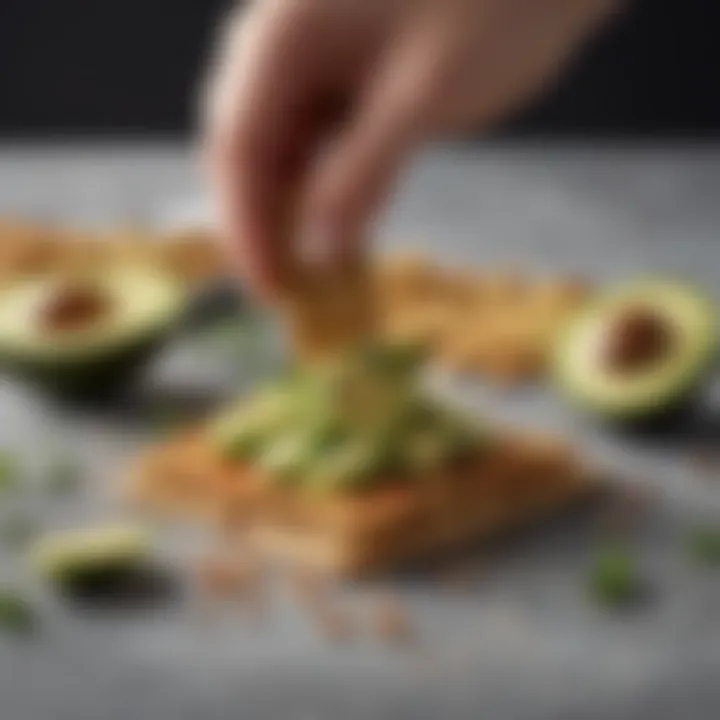Exploring Vege Crackers: Nutrition and Culinary Trends


Intro
The rise of plant-based diets has ushered in a new era in snacking, with vege crackers standing out as a popular choice among health-conscious consumers. These snacks not only serve as a tasty alternative to traditional crackers, but they also bring numerous nutritional benefits. As more people become aware of their dietary choices, the interest in vege crackers is growing. Exploring their origins, nutritional strengths, and culinary versatility provides valuable insights into this trend.
Vege crackers are made primarily from vegetables, grains, and seeds, which makes them inherently more nutritious compared to typical wheat-based crackers. This article aims to delve into the latest market trends, the array of available products, and how these snacks can be adroitly incorporated into diverse culinary contexts. Understanding the nuances of vege crackers helps food lovers appreciate their roles not just as standalone snacks, but as components of more elaborate dishes.
Recipe Overview
Recipe Name
Vegetable Herb Crackers
Description of the Dish
Vegetable Herb Crackers are crunchy, flavorful snacks that combine various vegetables with herbs and seeds to create a nutrient-dense option for health-focused diets. These crackers offer a great way to incorporate more veggies into one's diet, keeping in line with the plant-based trend. They can be enjoyed alone, paired with dips, or used as a topping for salads and soups. The versatility of these crackers makes them suitable for countless serving occasions.
Ingredients
List of Ingredients with Measurements
- 1 cup of finely grated zucchini
- 1/2 cup of grated carrot
- 1/4 cup of chia seeds
- 1/4 cup of ground flaxseed
- 1/2 cup of almond flour
- 1 teaspoon of dried oregano
- 1 teaspoon of garlic powder
- 1/2 teaspoon of salt
- 1 tablespoon of olive oil
- 1/4 cup of water
Special Notes on Ingredients
- Zucchini: Can be substituted with finely grated cucumber for a lighter flavor.
- Chia Seeds: Besides chia seeds, sunflower seeds can also be used for an added crunch.
- Almond Flour: For nut-free diets, replace almond flour with oat flour to maintain a gluten-free option.
"Incorporating more vegetables into your daily diet is not only beneficial for health, but it can also be enjoyable through innovative recipes like these Vegetable Herb Crackers."
These crackers embody the essence of health-focused snacking, presenting a delicious way to enjoy vegetables in a convenient format. Whether for yourself, a gathering, or family functions, they can be a delightful addition.
Preamble to Vege Crackers
Vege crackers have become an essential part of the snacking landscape, particularly as consumers shift toward more health-conscious eating habits. This section aims to provide a thorough understanding of vege crackers, discussing their relevance, key benefits, and considerations in today’s market.
Definition and Overview
Vege crackers are snacks made primarily from vegetables and often incorporate various healthful ingredients. Unlike traditional crackers, which may be rich in refined grains and unhealthy fats, vege crackers offer a more nutritious option. They are typically made by grinding vegetables, nuts, and seeds, mixed with flours and seasonings, and then baked or dehydrated.
This type of snack appeals to a wide audience, including those following plant-based diets or looking for healthier snack alternatives. Nutritionally, vege crackers can be rich in fiber, vitamins, and minerals, contributing positively to an individual's daily value requirements. Moreover, their versatility allows them to be incorporated into many culinary applications.
Historical Context
The inception of vege crackers can be traced back to ancient civilizations that utilized grains and vegetables in their diets. However, the modern incarnation began to gain traction in the late 20th century as a response to rising health consciousness. As people became more aware of health issues related to diet, manufacturers began creating snacks that provided better nutritional profiles.
Initially, these crackers were viewed as a niche market product, but over the years, they have entered the mainstream market. The proliferation of health food stores and organic products led to improved visibility. Today's vege crackers are often part of grocery store aisles, appealing to a diverse demographic. The awareness of allergies and dietary restrictions has also influenced the expansion of this product category.
In summary, vege crackers represent a significant evolution in snack foods. They not only satisfy cravings but do so with better health benefits. Understanding their background and definition sets the stage for exploring their nutritional aspects and culinary roles.
Nutritional Aspects of Vege Crackers
The nutritional aspects of vege crackers play a prominent role in understanding their value as a snack and as part of a balanced diet. In recent years, there has been a significant shift in consumer preferences towards healthier, plant-based eating. This trend has led to a resurgence in the popularity of vege crackers, which not only provide enjoyment but also contribute positively to nutritional intake. Understanding the nutrients that constitute these crackers is essential for anyone looking to make informed dietary choices.
Key Nutrients in Vege Crackers
Vege crackers contain several key nutrients that set them apart from conventional snacks. Here are some of the main components:
- Fiber: One of the most beneficial nutrients in vege crackers is fiber. It promotes digestive health and contributes to feelings of fullness, aiding in weight management.
- Vitamins: Many vege crackers are made from nutrient-rich vegetables like kale, spinach, or carrots, providing essential vitamins like Vitamin A, C, and K that support overall health.
- Minerals: Minerals such as iron, calcium, and potassium are often present, depending on the ingredients used. These are crucial for various bodily functions, including bone health and muscle function.
- Healthy Fats: Crackers made with nuts or seeds can contain omega-3 and omega-6 fatty acids, which are important for heart health and cognitive function.
In summary, vege crackers can be more than just a snack; they can provide significant nutritional benefits that support overall wellness.
Comparison with Traditional Crackers
When comparing vege crackers to traditional crackers, several differences emerge. Traditional crackers are often made from refined grains and can lack important nutrients. Here are some factors to consider:
- Nutritional Density: Vege crackers tend to have higher nutritional density due to the presence of vegetables and whole ingredients. Traditional crackers may offer empty calories with little nutritional value.
- Ingredient Quality: Many vege crackers utilize whole food ingredients, which may lead to a cleaner label without artificial additives. In contrast, traditional crackers frequently contain preservatives and refined ingredients.


"The growing interest in plant-based diets pushes for products like vege crackers that align with health consciousness."
- Taste and Texture: While traditional crackers can be bland, vege crackers often provide a variety of flavors. The incorporation of herbs and spices enhances the overall taste experience.
Types of Vege Crackers
The variety of vege crackers available today reflects changing consumer preferences and increasing awareness about health. Understanding the different types of vege crackers is important for both consumers and producers. Each type brings unique characteristics, flavors, and nutritional benefits. This section will cover essential types of vege crackers, helping readers make informed choices based on their dietary needs and culinary preferences.
Grain-Based Crackers
Grain-based crackers are noteworthy for their versatility and availability. These crackers often use whole grains as their base. Common grains include quinoa, brown rice, and oats. They can be appealing to those seeking gluten-free options, although some may contain wheat. Nutritionally, they provide fiber and complex carbohydrates, which are essential for a balanced diet.
The flavors offered by grain-based crackers can range from mild to robust, often enhanced by various spices or herbs. They pair well with a wide range of dips and can be used in salads or as a snack on their own. It is essential to check the ingredient list, as some commercial options may include preservatives or added sugars.
Vegetable-Specific Crackers
Vegetable-specific crackers showcase the flavor and nutrition of various vegetables. These crackers can be made predominantly from ingredients like beets, carrots, or kale. The emphasis on vegetables not only enhances taste but also increases the nutrient density of the crackers. For example, beet crackers are usually high in fiber and antioxidants, while carrot-based options provide beta-carotene.
These crackers cater to health-conscious consumers, offering a rich source of vitamins while satisfying the craving for crunchy snacks. They are ideal for pairing with hummus or guacamole, making for a nutritious snack or appetizer. However, like all products, one must consider potential allergens or sensitivities to certain vegetables.
Nut and Seed Crackers
Nut and seed crackers are a high-protein, low-carbohydrate option popular among those following paleo or keto diets. They typically contain a blend of nuts such as almonds or cashews, and seeds like chia or sunflower. These crackers are rich in healthy fats which can help in achieving satiety. The crunch and flavor profile tend to be more intense, appealing to a wide audience.
Another advantage is their simplicity - many recipes for nut and seed crackers require minimal ingredients and can be prepared at home. However, they do contain a higher caloric content compared to other cracker types. For those with nut allergies, caution is necessary when selecting store-bought versions.
Nut and seed crackers present a healthy alternative, promoting satiety and meeting dietary restrictions for protein consumption.
Each of these cracker types serves distinct purposes and caters to varied dietary preferences. As awareness regarding health and nutrition expands, the types of vege crackers continue to evolve, providing consumers with many options.
Ingredients Commonly Used in Vege Crackers
Understanding the ingredients in vege crackers is essential for appreciating their full potential. The choice of base ingredients and flavor enhancers can impact not just the nutritional value, but also the texture and taste profile of the final product. This section will discuss key components that contribute to the unique attributes of vege crackers.
Flours and Base Ingredients
The base ingredients in vege crackers often determine much of their character. Different flours serve distinct purposes, contributing to the texture and nutrient profile. Common flours used are chickpea flour, almond flour, and rice flour.
- Chickpea flour adds protein and fiber, which aids in digestion and provides satiety.
- Almond flour offers healthy fats and is often favored in gluten-free recipes.
- Rice flour gives a light texture but usually lacks fiber compared to the other options.
Another base ingredient worth mentioning is potato starch, used for binding and providing crispiness. Blending various flours can create a balanced cracker with unique properties. The choice largely depends on dietary restrictions and desired taste.
Flavor Enhancers and Additives
To elevate the sensory experience of vege crackers, various flavor enhancers and additives are commonly used. These can include a wide range of spices, herbs, and oils.
Spices such as cumin, paprika, or turmeric not only provide taste but also bring additional health benefits. These spices can enhance anti-inflammatory properties and improve overall flavor complexity.
- Herbs like rosemary and thyme add aromatic layers to the crackers, appealing to discerning palates.
- Oils, often olive oil or coconut oil, improve mouthfeel and provide necessary fats. This combination of oils with spices creates a taste that stands out.
Additives such as nutritional yeast are also popular. This ingredient lends a cheesy flavor without dairy, appealing to various dietary preferences.
Overall, the thoughtful selection of ingredients in vege crackers influences both health benefits and culinary applications. It presents an opportunity to innovate and cater to diverse consumer tastes.
Health Benefits of Vege Crackers
The increasing shift toward healthier snacking options has elevated the importance of understanding the health benefits associated with vege crackers. These snacks not only serve as a delicious alternative to traditional crackers but also offer a range of nutritional advantages that cater to health-conscious consumers. In this section, we will delve into two primary aspects: weight management and digestive health considerations, which highlight the overall health profile of vege crackers.
Weight Management and Satiety
Weight management is a common concern for many individuals. Vege crackers can be a valuable addition to a diet aimed at maintaining or losing weight. Unlike typical snacks high in empty calories, vege crackers are often made from whole food ingredients, which contribute to a more satiating experience.
- High Fiber Content: Many vege crackers contain ingredients rich in dietary fiber. Fiber promotes feelings of fullness, which can help reduce overall calorie intake throughout the day. Foods high in fiber require longer chewing and digestion times, leading to increased satiety.
- Lower Caloric Density: While enjoying a delicious snack, vege crackers generally have a lower caloric density compared to their traditional counterparts. This means you can consume a satisfying portion without consuming excessive calories, making them a practical choice for those monitoring their weight.
Incorporating these crackers into meals or enjoying them between meals can effectively curb hunger pangs. The result is a balanced approach to snacking that supports weight management efforts.
Digestive Health Considerations


Digestive health is crucial for overall well-being, and vege crackers can play a supportive role in maintaining a healthy digestive system. Their formulation typically accommodates ingredients that contribute positively to gut health.
- Natural Ingredients: Many vege crackers prioritize natural ingredients without additives or preservatives. This quality is significant because certain artificial ingredients can disrupt gut flora, while natural components support digestive balance.
- Probiotics and Prebiotics: Depending on the formulation, some vege crackers will include added probiotics or prebiotics. Probiotics are beneficial bacteria that promote gut health, while prebiotics serve as food for these bacteria.
Incorporating vege crackers into your diet can enhance not just snacking experiences but also overall digestive health.
These points underscore why vege crackers are more than just a trendy snack; they represent a conscious choice towards better health. It is clear that both weight management and digestive health are pivotal reasons for including vege crackers in a balanced diet.
Culinary Applications of Vege Crackers
When discussing vege crackers, culinary applications are a vital aspect that showcases their versatility in various food contexts. These snacks are not just standalone items; they can dynamically complement a wide range of dishes and occasions. Understanding how to effectively incorporate vege crackers into meals can elevate both nutritional value and aesthetic appeal. In today's health-focused culinary scene, the roles vege crackers play can significantly enhance both flavor and texture in diverse preparations.
Serving Suggestions
Dip Pairings
Dip pairings are an excellent way to elevate the experience of vege crackers. They provide a balance of flavor and texture. By pairing vege crackers with dips, such as hummus or guacamole, one can enjoy a nutritious and satisfying snack. The key characteristic of dip pairings is that they allow for experimentation with different flavor profiles. This versatility makes them a popular choice in various culinary applications. Unique features of dip pairings include the ease of preparation and the ability to enhance the taste without adding extra calories. However, it is crucial to consider the nutritional value of the dips, as some may add unnecessary fats or sugars.
Cheese and Charcuterie Boards
Cheese and charcuterie boards prominently feature vege crackers as a component that adds both crunch and flavor variety. Their inclusion provides a delightful contrast to creamy cheeses and savory meats. One key characteristic of these boards is their visual and taste appeal, making them suitable for gatherings or as an elegant snacking option. Vege crackers typically enhance the overall flavor profile without overshadowing the main elements. A unique feature is their ability to accommodate various dietary preferences, such as gluten-free or vegan diets. Nevertheless, one must pay attention to portion sizes, as overindulgence in charcuterie can lead to excessive caloric intake.
Salads and Soups
Incorporating vege crackers into salads and soups provides an innovative textural element. They can be crumbled on top of a fresh salad for added crunch or served alongside a bowl of soup to enhance the experience. The key characteristic of using vege crackers in this way is their ability to absorb flavors from the dishes while retaining their crispiness. This is a beneficial approach, as it can turn a simple meal into something more dynamic. A unique feature of this application is the ease of creating combinations that suit various palates. However, it's important to consider that some crackers may become soggy in liquids, which may not be the desired outcome.
Incorporating in Recipes
Cracker Crusts
Cracker crusts offer a unique twist on traditional pie or tart bases. By utilizing crushed vege crackers as a base, you can create a flavorful and crunchy bottom layer for quiches or desserts. A key characteristic of cracker crusts is their straightforward ingredient list, which allows for customization in taste and texture. This application is particularly beneficial for those following gluten-free diets, as alternatives to traditional flour crusts can be easily achieved. The unique feature here is the ability to cater to dietary restrictions while still delivering on taste. On the downside, achieving the perfect texture can take some experimentation, as not all crackers bind as well as others.
Canapés
Canapés made with vege crackers provide a sophisticated bite-sized treat for gatherings. They can easily be topped with various spreads and toppings, creating a delightful medley of tastes and textures. The key characteristic of canapés is their ability to impress guests with minimal effort. Utilizing vege crackers ensures allergen-friendly and health-conscious options that maintain visual appeal. Unique aspects include the various topping combinations that can be utilized, from savory to sweet. One challenge can be ensuring that the toppings do not overpower the delicate flavor of the cracker itself.
Layered Dishes
Layered dishes using vege crackers introduce a delightful component that enhances both flavor and structure. This application can range from layered dips to lasagna-style recipes that alternate layers of crackers, vegetables, and sauces. A key characteristic of layered dishes is their visual and textural appeal as they allow for easy assembly and great presentation at dining events. This method can be a beneficial approach for meal prep, as layers are easily customizable. The unique feature is the ability to incorporate various seasonal vegetables and flavors, making it adaptable to personal preferences. However, attention must be given to maintain balance in flavors to prevent any one element from dominating the dish.
Trends in the Vege Cracker Market
Understanding the trends in the vege cracker market is crucial for both consumers and producers. This section highlights the key elements underpinning the rise of vege crackers and their significance in today's snack landscape. We observe an increased health consciousness among consumers, a shift towards plant-based foods, and broader culinary applications.
Rising Popularity of Plant-Based Snacks
The interest in plant-based snacks like vege crackers is at an all-time high. This trend stems from several factors. First, health awareness is influencing dietary choices. Many people are seeking snacks that are not only tasty but also nutritious. Research shows that consumers are looking for products that are lower in calories and free of artificial ingredients.
Moreover, the environmental impact of food choices is becoming more pronounced. Consumers are inclined to support products that have sustainable sourcing and minimal environmental footprints. Vege crackers, often made from vegetables and whole grains, fit well into this preference.
The variety in flavors and textures available in vege crackers also contribute to their popularity. Unlike traditional snacks, vege crackers can be seasoned and flavored in numerous ways, appealing to a broader audience. People enjoy experimenting with different brands to discover unique tastes that align with their preferences.
Target Demographics and Consumer Preferences
Identifying the target demographics for vege crackers reveals interesting insights into consumer preferences. Health-conscious individuals, including fitness enthusiasts, find vege crackers appealing due to their nutritional value. Moreover, parents are increasingly opting for healthy snacks for their children, making vege crackers appropriate for family snacking.
Young adults, particularly those in urban environments, are drawn to convenient on-the-go snacks that fit their busy lifestyles. It becomes evident that packaging plays a vital role. Many consumers prefer single-serving packs that are easy to carry and eat. Brands are responding by improving their packaging to enhance convenience without compromising the product's quality.
"As consumer preferences evolve, the demand for vege crackers grows, bridging health and convenience across various age groups."
The market is also seeing increased demand from vegans and vegetarians. They appreciate the wide range of flavor combinations and the nutritious content typical of vege crackers. This segment influences product formulations and encourages more brands to innovate. Overall, understanding these trends helps manufacturers align their offerings with market demands.
Sourcing and Sustainability Considerations
Sourcing and sustainability are essential components in the production and consumption of vege crackers. As health-conscious consumers increasingly seek products that not only meet their dietary needs but also align with their ethical values, these considerations have gained significant importance. Vege crackers, made from vegetables, grains, nuts, and seeds, present an opportunity to support sustainability efforts. These snacks can positively impact both individual health and the environment.
Ingredient Sourcing Practices


Ingredient sourcing is crucial in creating vege crackers that are both nutritious and sustainable. The choice of raw materials affects the overall quality of the product. Many manufacturers prioritize locally sourced ingredients to minimize carbon footprints associated with transportation. This practice also supports local economies, encouraging small-scale farmers to cultivate crops specifically for snack production.
Moreover, the trend towards organic ingredients sees a rise in demand for products that are free from harmful pesticides and genetically modified organisms. Organic agriculture contributes to healthier soil and ecosystems, which can enhance the nutritional value of crops. Conscious sourcing practices promote transparency, allowing consumers to feel assured that their snacks are not only delicious but also ethically produced.
Environmental Impact of Production
The environmental impact of vege cracker production is a critical concern. Traditional farming methods can lead to soil degradation, water overuse, and loss of biodiversity. In contrast, sustainable agricultural methods focus on preserving these natural resources. For example, crop rotation and organic farming help maintain soil health and reduce chemical runoff into waterways.
Furthermore, the manufacturing process plays a role in sustainability. Reducing energy consumption during production and utilizing eco-friendly packaging can enhance the overall sustainability profile of vege crackers. Manufacturers are encouraged to adopt practices that lower emissions and waste while also maximizing resource efficiency.
"Sustainable practices in food production not only benefit the environment but also create products that consumers can trust and support."
By considering the environmental impacts associated with both ingredient sourcing and production practices, the vege cracker industry can pave the way for a more sustainable snacking future. This dual focus ensures that these products not only serve immediate consumer needs but also contribute positively to global sustainability efforts.
Homemade vs. Store-Bought Vege Crackers
The choice between homemade and store-bought vege crackers is integral in understanding their overall value, taste, and health benefits. Both options offer unique advantages and challenges that cater to varying consumer preferences and lifestyles. The discussion will focus on the benefits of creating enjoyable homemade versions and evaluating the quality of commercially prepared alternatives. This analysis is significant as it helps food enthusiasts choose the best crackers tailored to their dietary needs and culinary applications.
Advantages of Homemade Vege Crackers
Making vege crackers at home comes with several advantages that appeal to health-conscious consumers. Here are some notable points:
- Control Over Ingredients: Homemade crackers give you complete control over every ingredient. You can select high-quality, organic vegetables and flours, allowing for an optimized nutritional profile without preservatives or artificial additives.
- Customization: You can tailor recipes to suit personal taste preferences, dietary restrictions, or specific nutritional needs. For instance, if you prefer a cracker with a strong flavor profile, you can adjust herbs and spices to your liking.
- Freshness and Taste: Crackers made from fresh ingredients tend to have a richer taste and texture. The taste experience can notably enhance when using vegetables that are in season, providing both flavor and nutrition.
- Cost-Effectiveness: While initial ingredient purchases may be higher than a pack of store-bought crackers, making a large batch at home can often be more economical in the long run, especially when considering quality and portion size.
- Creative Expression: Homemade crackers offer an avenue for culinary creativity. Experimenting with various combinations and cooking methods can result in unique snacks that can impress your family and friends.
Evaluating Store-Bought Options
While homemade vege crackers present several benefits, store-bought options also hold their own place in the market. Evaluating these products requires consumers to consider several factors:
- Ingredient List: A critical step in assessing store-bought crackers is reading the ingredient list. Look for products that prioritize whole, minimally processed ingredients, and avoid those laden with fillers and unhealthy additives.
- Nutritional Information: Check for essential nutrients such as fiber, protein, and healthy fats. Some brands market themselves as healthy, but nutritional content can vary significantly.
- Taste and Texture: The flavor and crunchiness of store-bought crackers vary. Trying out different brands can lead to finding a product that meets your taste expectations. Brands like Mary’s Gone Crackers or Earth Balance offer diverse tastes and textures that can appeal to many.
- Price vs. Quality: There is often a trade-off between price and quality. Higher-priced options might contain better ingredients and taste better. It’s essential to find a balance that works for your budget while not compromising on health.
- Availability: Depending on local markets and stores, some consumers may find it easier to access high-quality store-bought options instead of spending time making crackers at home.
In summary, both homemade and store-bought vege crackers have unique advantages and considerations. A specific choice will depend on individual preferences concerning health, taste, convenience, and ethical considerations.
Innovations in Vege Cracker Production
The production of vege crackers is experiencing a wave of innovations that significantly enhance their appeal and nutritional value. These advancements reflect a growing consumer demand for healthier, sustainable snack options. Innovation in this sector is crucial as it not only improves the sensory attributes of vege crackers but also addresses health and dietary concerns. By focusing on new ingredients and technologies, the industry aims to cater to a broad audience that values quality along with taste.
New Ingredients and Technologies
Recently, manufacturers have begun to explore novel ingredients that offer health benefits while still satisfying consumer cravings. For instance, the use of alternative flours such as chickpea, almond, or coconut flour provides gluten-free options that cater to gluten-sensitive individuals. These alternative bases are not only nutritious but can also impart unique flavors to the final product.
Technological advancements also play a key role in production. High-pressure processing (HPP) is one method that extends the shelf life of vege crackers while preserving their nutrients. This technology uses pressure instead of heat, maintaining the natural flavor and quality of ingredients. Other technological improvements include better packaging solutions that enhance freshness and reduce waste.
Utilizing functional ingredients like chia seeds and flaxseeds fortifies vege crackers with extra fiber and omega-3 fatty acids. Not only do these ingredients contribute to overall health, but they also create appealing textures that enhance the eating experience. The flexibility in ingredient choices allows manufacturers to tailor products to specific dietary needs, thus attracting a diverse customer base.
Trends in Flavor Profiles
As palates evolve, so do flavor preferences. Innovation in flavor profiles is essential to keep vege crackers competitive in a saturated market. Today's consumers seek more intense, globally-inspired flavors that go beyond the traditional. Savory options featuring ingredients such as smoked paprika, chipotle, or even umami-rich seaweed cater to adventurous eaters.
Sweet flavors are also gaining traction, with products incorporating natural sweeteners like agave or monk fruit, paired with spices such as cinnamon or ginger. This fascination with unique flavors offers a wider range of snacking experiences. Additionally, spicy elements have become a popular trend, appealing to consumers who enjoy a bit of heat in their food.
As a result of these innovations in flavor profiles, vege crackers can serve more than just a snack. They transform into versatile ingredients that can enhance various dishes or standalone appetizers. The explosion of flavor options allows consumers to discover and enjoy different dimensions of snacking.
"The continuous evolution in vege cracker production signifies an essential intersection of health trends and culinary creativity."
Closure
The examination of vege crackers throughout this article reveals their growing significance in modern diets. Understanding their nutritional benefits and culinary versatility addresses the increasing demand for healthier snack alternatives. This section emphasizes several vital elements that contribute to their popularity.
Summary of Key Insights
In summary, vege crackres present numerous benefits:
- Nutritional Benefits: They often contain essential nutrients such as fiber, vitamins, and minerals, making them a better choice than traditional snacks.
- Culinary Versatility: The potential to use them in various dishes, from appetizers to main courses, showcases their adaptability.
- Market Trends: A surge in plant-based diets and health-focused eating contributes to their rising appeal among consumers. This shift is not just a fleeting trend; it reflects broader lifestyle changes towards sustainability and health considerations.
Each of these insights reinforces the notion that vege crackers are not merely a snack but a significant food group that can play a central role in a balanced diet.
Future Directions for Vege Crackers
The future of vege crackers looks promising. Several developments suggest new horizons in this sector:
- Flavor Innovations: Manufacturers are likely to explore diverse flavors, appealing to a wider audience. Integrating unique ingredients like superfoods can enhance their market position.
- Health Focus: With a continuous increase in health-conscious consumers, more brands will prioritize functional ingredients that promise additional benefits, such as better gut health or reduced inflammation.
- Sustainable Practices: As environmental concerns grow, the industry may lean towards more sustainable sourcing methods and packaging solutions.
To conclude, the continued evolution of vege crackers in response to consumer preferences and global trends illustrates their importance in today’s food landscape. Engaging with this product not only supports individual health but also encourages broader sustainable practices within the food industry.







